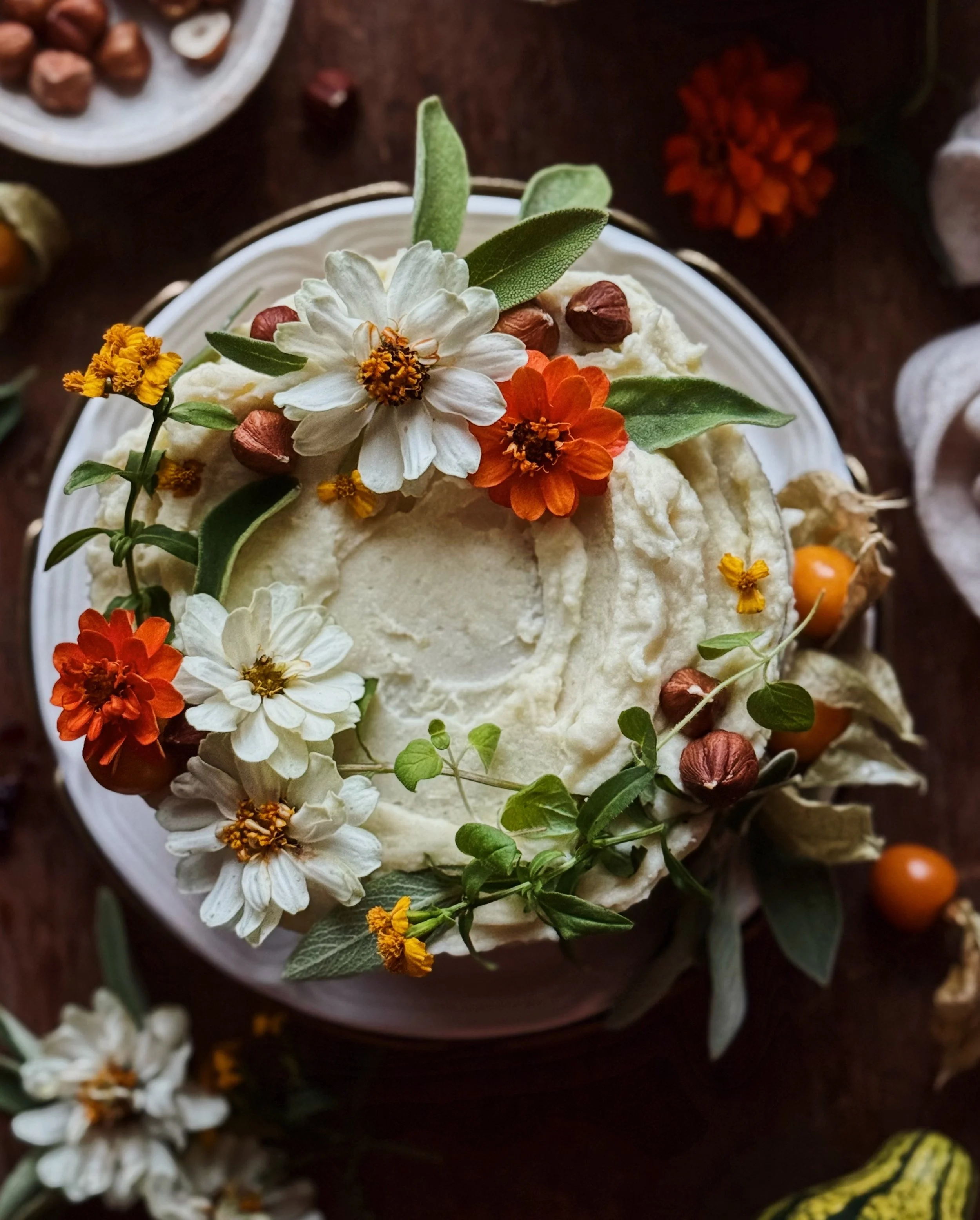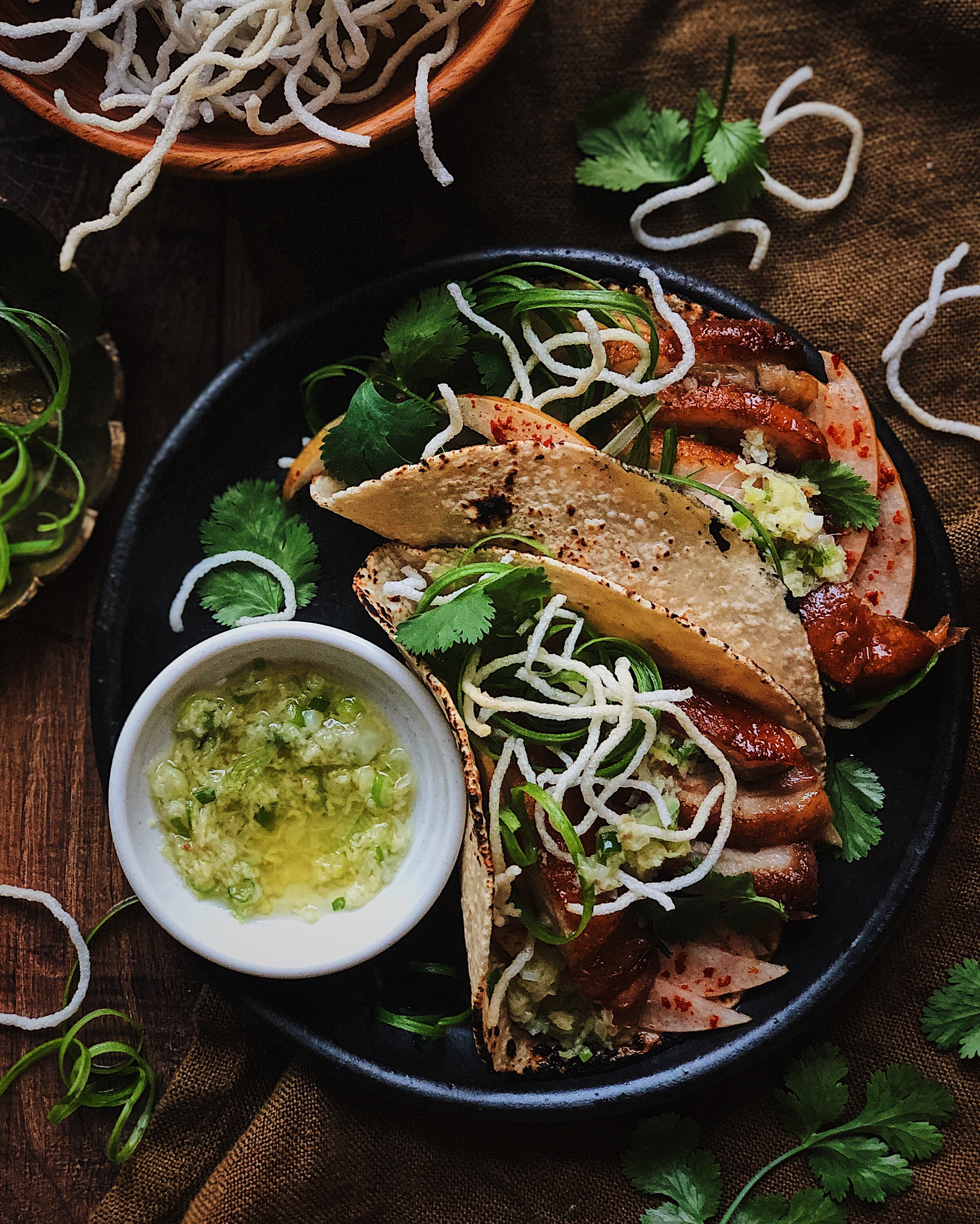Recipe: Spring Veggie Crostini with Green Chili Cheese Spread
/For this recipe, I partnered with Cabot Creamery to come up with something that is deliciously cheesy and also celebrates the beautiful produce that the spring season has to offer. One of the things I love about spring is that everything is so green! Here in Northern California, everything from the rolling hills with grazing farm animals to the heaps of fresh offerings at the farmers markets is lush shades of green right now. All of this inspired me to make this Cabot cheddar-based cheese spread with roasted green chilies and green garlic. It’s my take on pimento cheese with a spring green twist, and I hope you find it as addictive as I do!
I wasn’t sure if I could call it “green pimento cheese” because there aren’t actually any pimento peppers in this, but that’s the easiest way to describe what I was going for and I am so pleased with how it turned out in the end. Pimento cheese is a cheese spread associated with cuisine of the American South and it is named for the red pimento peppers (also known as pimiento peppers or cherry peppers) that are mixed throughout. My version combines roasted Anaheim green chilies, green garlic (more on this later), some dry spices, and Cabot Vermont Sharp Cheddar—the one in the green plaid wrapper! I chose this cheddar because it’s a great everyday sharp cheddar that my friends at Cabot recommend for sauces and dips; it brought a nice tang that held up to the flavors from the produce.
This cheesy spread can be used in so many ways. It is great as a dip for seasonal crudité, spread on crackers, slathered into burgers, and so much more. But I thought I’d show it off in the way that I personally best know how—on some pretty spring-themed mini toasts! These crostini are an extension of that spring farmers market theme; I went to the market planning to just grab a baguette and some green garlic if I could find it and then next thing I knew I was bumping elbows with the other aunties picking out the plumpest looking snap peas and the prettiest pea shoots. When I think of what’s in season in the spring, I definitely think of peas, so it felt fitting to feature them on top of my spring crostini, along with sunflower sprouts, little bits of radish, and edible flowers, all with my green chili cheese spread to hold them down onto the slices of toasted baguette.
Notes on the key ingredients, prep, and substitutions for the Green Chili Cheese Spread
Anaheim Chili Peppers: I chose to feature these chili peppers in my green chili cheese spread because they are very mild, have a nice fresh vegetal flavor, and tend to have a flattened shape which makes them easier to roast evenly. For this recipe, you will be completely charring them until the skins are black and papery and easily sloughed off. My preferred way to do this is directly on my gas stove as this allows me to keep moving them around until they are blackened all over. If you do not have a gas cooktop, you could do this over an open grill or under a broiler; just be sure to keep moving and rotating the peppers as needed to get an even char.
Green Garlic: Green garlic is a result of farmers thinning out their garlic crop; these get pulled out of the ground in the spring while other garlic plants stay in the ground until the bulbs develop into the mature form that gets dried and becomes what we think of when we think of garlic. It is milder in flavor than mature garlic and can be found only in the springtime, at farmers markets or some local grocery stores that tend to source more directly from farmers. To prepare the green garlic for this recipe, you will only be using the white immature bulb with the roots trimmed off and up to the tender light green stalk, below the tough dark green leaves. Similar to how you prepare an onion, you’ll want to peel away the tougher outer layer of the stalk (usually the pretty purple part). You’ll be briefly soaking the chopped green garlic to take away some of the raw sharpness. If you can’t find green garlic, substitute 1–2 small cloves of peeled garlic and use boiling hot water for the soaking step.
Japanese Mayo: I used Japanese-style mayonnaise because it’s the only kind I buy and I like creaminess and slight sweetness in the flavor. You can definitely sub in with whatever mayo you have.
Dried Spices: Ground cumin and coriander add depth of flavor to the spread, and make it smell so good. While it is always best to toast whole dried seeds and grind them right before use, I opted to go with store bought ground cumin and ground coriander when I was testing this recipe and they still brought a lot of complexity to the spread.
Sharp Cheddar: This recipe uses a whole dairy bar of Cabot Vermont Sharp Cheddar so you’ll have more than enough cheese spread for the crostini portion of the recipe and you can use the rest as a dip, on sandwiches, and more. This cheese has a creamy texture and a nice buttery tang, and just the right amount of sharpness for making a versatile spread/dip. As a bonus, all Cabot Cheddars contain zero grams of lactose per serving so you can whip this up for a party even if you have lots of lactose-sensitive friends like I do.
Green Chili Cheese Spread Variations
Because I was making the spread mainly to use on crostini, I processed the ingredients well in the food processor to produce a more homogeneous consistency. But don’t expect something silky smooth when you are blending the ingredients together since you are working with a block cheddar here; instead, look for a texture similar to baba ganoush.
If you are planning on using this as a dip for crudité or for a burger spread, you could choose to keep the texture a bit more chunky if you prefer. Withhold one of the roasted peppers from the food processor and finely chop it with a knife. When adding the cheddar, process half of the amount first and then lightly pulse in the rest. Then fold in that chopped roasted pepper manually.
Notes on Making the Crostini
The written recipe below will show you what you need to make the crostini in the photos. But don’t feel like you need to precisely measure anything for that portion of the recipe! This green chili cheese spread will work perfectly with so many veggies and if you are able to visit a local farmers market before making your crostini, I encourage you to get what speaks to you.
Here’s a full list of what I used:
Snap Peas: To make these more Insta-worthy, I cut off one half of each pea pod (and snacked on the discarded pieces while I worked). You can definitely skip this step, but if you want to achieve this look, use a sharp paring knife and run the tip just to the side of the natural seam that holds the pod together, and it will come right off.
Pea Shoots and Tendrils: These are the leaves and tendrils of a pea plant; other than at farmers markets, I see them at Asian supermarkets since we often cook them for a simple veggie dish. Usually pea shoots are sold with three segments attached together: the tendril, a thin stem with small-ish symmetrically shaped leaves, and then a thicker hollow stem part with bigger leaves. I used only the first two parts for my crostini.
Frozen Peas: I supplemented the pea pods with some frozen peas to fill in some of the gaps as I was decorating the crostini. This ingredient can definitely be skipped if you want to keep to all fresh toppings.
Radish Slices: The tiny little flower shapes you see sprinkled over the crostini are made from French breakfast radishes and purple daikon! I sliced them thinly and then used a tiny flower-shaped fondant cutter to punch out the flower shape. If you do not have a tool like this, simply slicing French breakfast radishes into thin disks would still look so pretty.
Sunflower Sprouts: Another young green that brings a springtime vibe to the crostini, the succulent leaves of sunflower sprouts hold up much better on an appetizer table than most microgreens. These come with long, crisp stems attached but I only used the leaves to decorate my crostini.
Edible Flowers: I grew these pansies myself and love decorating my toasts with them but they do not contribute much to the taste of the crostini, so you can omit them if you don’t have them. Remember that not all flowers are safe to eat; be very certain about what you have before incorporating flowers into your food. Alternatively, I actually have a tutorial for how to make very edible pansies/violas cut out of purple daikon, which would be perfect for these crostini; you can check that out here.
Because I found myself snacking on whatever veggie scraps I had as I was testing this cheese spread recipe, the idea of crudités really stuck in my mind. So, in a way, my crostini are like mini self-contained edible crudité platters. Whether you opt for this approach or choose to layer something different over your green chili cheese spread, I hope your spring crostini bring you joy to admire and then promptly devour!
How to Make Spring Veggie Crostini with Green Chili Cheese Spread
Ingredients for the Cheese Spread
4 large Anaheim chili peppers
2 stalks (about 6–8 inches each) green garlic, trimmed and coarsely chopped
1 lemon
1/4 cup Japanese-style mayonnaise
1/4 tsp kosher salt
1 tsp ground cumin
1 1/2 tsp ground coriander seed
8 oz (1 dairy bar) Cabot Vermont Sharp Cheddar, grated
Ingredients for the Crostini
1 baguette
4–6 tsp extra virgin olive oil
1 1/2–2 cups Green Chili Cheese Spread
pea shoots and tendrils
48 snap peas
1/4 cup frozen peas, thawed
4 french breakfast radishes, thinly sliced
2 oz purple daikon, thinly sliced
16+ edible flowers, such as pansies (optional)
Procedure
To make the cheese spread: Char chili peppers directly on a gas stove (or a grill or under a broiler) rotating and moving often until the skins are completely black and papery. Transfer charred peppers immediately to a brown paper bag (set over a plate to catch the moisture) or a container with a lid (a bowl and plastic wrap works). Seal in the peppers to trap the steam and allow to rest until cool enough to handle.
In the meantime, zest and juice the lemon. Set aside the zest plus 2 teaspoons of the juice. In a bowl, combine the remaining lemon juice, the chopped green garlic, and 1/4 cup lukewarm water. Allow to soak for at least 3 minutes to remove some of the raw bite of the green garlic (or longer if you are sensitive to this flavor). Then drain away the liquid and set green garlic aside.
When the chili peppers are safe to handle, slough off and rinse away all the charred skin. Discard the tops, the seeds, and any pith. Pat dry thoroughly and roughly chop.
In a food processor, combine the chopped roasted peppers, drained green garlic, mayonnaise, seasonings, and the reserved lemon juice and zest. Process until a puree-like texture is formed. Add half the cheddar and process until homogenous. Add the remaining cheddar and pulse to the desired consistency, or process until homogenous.
The cheese spread can be stored in a clean jar in the fridge for up to 1 week. For making the crostini on another day, allow the spread to come to room temperature for smoother handling.
To make the crostini: Prepare the pea pods and radishes as desired for food styling (see notes in above blog post for details on food styling).
Preheat oven to 475°F.
Trim away the end parts of the baguette and slice the rest on a bias into about 16 slices. Brush each slice on one side with olive oil and place on a baking tray. Bake/toast in the oven for 4–7 minutes, depending on how dark and crunchy you want your crostini.
For each slice, spread on about 2 tablespoons of the prepared cheese spread. Start decorating with the pea shoots, then about 3 snap pea pods, then the edible flowers to establish the general layout. Then fill gaps with the frozen peas, sunflower sprouts, and the radish/daikon slices. Add extra pea tendrils for extra flair. Repeat for the remaining baguette slices and have fun decorating pretty spring toasts!
Thank you so much to Cabot Creamery for sponsoring this recipe! Visit their website to find out where you can get their excellent cheeses, such as their naturally-aged cheddars, near you!






















